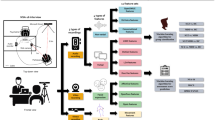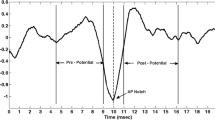Abstract
Bipolar disorder (BD) is a severe mood disorder that lacks established electrophysiological, neuroimaging or biological markers to assist with both diagnosis and monitoring disease severity. This study’s aim is to describe the potential of new neurophysiological features assistive in BD diagnosis and severity measurement utilizing the recording of electrical activity from the outer ear canal called Electrovestibulography (EVestG). From EVestG data sensory vestibulo-acoustic features were extracted from a single supine-vertical translation stimulus to distinguish 50 depressed and partly remitted/remitted bipolar disorder patients [18 symptomatic (BD-S, MADRS > 19), 32 reduced symptomatic (BD-R, MADRS ≤ 19)] and 31 age and gender matched healthy individuals (controls). Six features were extracted from the measured firing pattern interval histogram and the extracted shape of the average field potential response. Five of the six features had low but significant correlations (p < 0.05) with the MADRS assessment. Using leave-one-out-cross-validation, unbiased parametric and non-parametric classification routines resulted in 75–79%, 84–86%, 76–85% and 79–82% accuracy for separation of control from BD, BD-S and BD-R as well as BD-S from BD-R groups, respectively. The main limitation of this study was the inability to fully disentangle the impact of prescribed medication from the responses recorded. A mix of stationary and movement evoked EVestG features produced good discrimination between control and BD patients whether BD-S or BD-R. Moreover, BD-S and BD-R appear to have measurably different pathophysiological manifestations. The firing pattern features used were dissimilar to those observed in a prior major depressive disorder study.

From [4] with permission, Taylor & Francis, http://www.tandfonline.com





Similar content being viewed by others
Abbreviations
- AD:
-
Antidepressant medication
- AMPA:
-
a-Amino-3-hydroxy-5-methyl-4-isoxazolepropionic acid
- Background phase:
-
1.5 s EVestG recording immediately prior to motion
- BD:
-
Bipolar disorder, (-S) symptomatic, (-R) reduced symptomatic (-R can be broken into (-M) mild and (-A) asymptomatic)
- EVestG:
-
Electrovestibulography
- FP:
-
Field potential
- IH1, IH2:
-
EVestG short interval features. Intervals were the time between detected FP’s
- IH331, IH332:
-
EVestG long interval features. Intervals were the time between each 33rd FP
- LDA:
-
Linear discriminant analysis
- MADRS:
-
Montgomery Asberg Depression Rating Scale
- MDD:
-
Major depressive disorder, (-S) symptomatic, (-R) reduced symptomatic
- MS:
-
Mood stabilizer medication
- NDMA:
-
N-methyl-d-aspartate
- AP:
-
Antipsychotic medication
- NEER:
-
Neural event extraction routine
- NM:
-
No-medication
- NPC:
-
Non-parametric classifier
- Acceleration phase:
-
1.5 s EVestG recording during the acceleration phase
- Deceleration phase:
-
1.5 s EVestG recording during the deceleration phase
- Sh1, Sh2:
-
EVestG shape features
References
Ghaemi SN, Boiman EE, Goodwin FK (2000) Diagnosing bipolar disorder and the effect of antidepressants: a naturalistic study. J Clin Psychiatry 61:804–808
Ghaemi SN, Sachs GS, Chiou AM, Pandurangi AK, Goodwin K (1999) Is bipolar disorder still underdiagnosed? Are antidepressants overutilized? J Affect Disord 52:135–144
Rosa AR, Andreazza AC, Kunz M, Gomes F, Santin A, Sanchez-Moreno J et al (2008) Predominant polarity in bipolar disorder: diagnostic implications. J Affect Disord 107(1–3):45–51
Lithgow BJ, Garrett AL, Moussavi ZM, Gurvich C, Kulkarni J, Maller JJ et al (2015) Major depression and electrovestibulography. World J Biol Psychiatry 16(5):334–350
Schmitt A, Falkai P (2013) Differential diagnosis of major depression and bipolar disorder. Eur Arch Psychiatry Clin Neurosci 263(2):83–84
Gurvich C, Maller JJ, Lithgow B, Haghgooie S, Kulkarni J (2013) Vestibular insights into cognition and psychiatry. Brain Res 1537:244–259
Marlinsky V (1995) The effect of somatosensory stimulation on second-order and efferent vestibular neurons in the decerebrate decerebellate guinea-pig. Neuroscience 69:661–669
Li C, Zhang Y, Guan Z, Shum DKY, Chan Y (2005) Vestibular afferent innervation in the vestibular efferent nucleus of rats. Neurosci Lett 385:36–40
Wang J, Chi F, Xin Y, Regner MF (2013) The distribution of vestibular efferent neurons receiving innervation of secondary vestibular afferent nerves in rats. Laryngoscope 123(5):1266–1271
Balaban CD, Jacob RG, Furman JM (2011) Neurologic bases for comorbidity of balance disorders, anxiety disorders and migraine: neurotherapeutic implications. Expert Rev Neurother 11(3):379–394
Hegerl U, Herrmann WM, Ulrich G, Muller-Oerlinghausen B (1990) Effects of lithium on auditory evoked potentials in healthy subjects. Biol Psychiatry 27:555–560
Fisman M (1975) Superior olivary complex in psychotic patients. Psychol Med 5(2):147–151
Vlaski L, Dragicević D, Dankuc D, Kljajić V, Lemajić-komazec S, Komazec Z (2008) Psychogenic hearing impairment in differential diagnosis of sudden hearing loss. Med Pregl 61(Suppl 2):31–35
Hasson D, Theorell T, Benka Wallén M, Leineweber C, Canlon B (2011) Stress and prevalence of hearing problems in the Swedish working population. BMC Public Health 11:130
Horner KC (2003) The emotional ear in stress. Neurosci Biobehav Rev 27(5):437–446
Pinto PC, Marcelos CM, Mezzasalma MA, Osterne FJ, de Melo Tavares de Lima MA, Nardi AE (2014) Tinnitus and its association with psychiatric disorders: systematic review. J Laryngol Otol 128(8):660–664
Paulin J, Andersson L, Nordin S (2016) Characteristics of hyperacusis in the general population. Noise Health 18(83):178–184
Marriage J, Barnes MM (1995) Is central hyperacusis a symptom of 5-hydroxytryptamine (5-HT) dysfunction? J Laryngol Otol 109(10):915–921
Lithgow BJ (2012) A methodology for detecting field potentials from the external ear canal: NEER and EVestG. Ann BME 40(8):1835–1850
Blakley B, Suleiman A, Rutherford G, Moussavi Z, Lithgow BJ (2018) EVestG recordings are vestibuloacoustic signals. J Med Biol Eng. https://doi.org/10.1007/s40846-018-0398-6
Suleiman A, Lithgow B, Dastgheib Z, Mansouri B, Moussavi Z (2017) Quantitative measurement of post-concussion syndrome (PCS) using Electrovestibulography (EVestG). Sci Rep (Nature). https://doi.org/10.1038/s41598-017-15487-2
Lithgow BJ, Shoushtarian M (2015) Parkinson’s disease: disturbed vestibular function and Levodopa. J Neurol Sci 353(1–2):49–58
Dastgheib Z, Lithgow BJ, Blakley B, Moussavi Z (2014) A new diagnostic vestibular evoked response. J Otolaryngol Head Neck Surg 44(1):14
Montgomery SA, Asberg M (1979) A new depression scale designed to be sensitive to change. Br J Psychiatry J Ment Sci 134:382–389
Heibert D (2010) Computer models of the vestibular head tilt response, and their relationship to EVestG and Meniere’s disease. Doctor of Philosophy, Monash University
Soza Ried AM, Aviles M (2007) Asymmetries of vestibular dysfunction in major depression. Neuroscience 144(1):128–134
Soza AM, Barroilhet S, Vohringer PA (2017) A vestibular biomarker of manic and depressive phase in bipolar disorder. Asia Pac J Clin Trials Nerv Syst Dis 2(4):140–145
Brown DJ, Patuzzi RB (2010) Evidence that the compound action potential (CAP) from the auditory nerve is a stationary potential generated across dura mater. Hear Res 267:12–26
McLachlan GJ (1992) Discriminant analysis and statistical pattern recognition. Wiley, New York
Niculescu AB (2013) Convergent functional genomics of psychiatric disorders. Am J Med Genet Part B 9999:1–7
Tkachev D, Mimmack ML, Ryan MM, Wayland M, Freeman T, Jones PB et al (2003) Oligodendrocyte dysfunction in schizophrenia and bipolar disorder. Lancet 362(9386):798–805
Davis KL, Haroutunian V (2003) Global expression-profiling studies and oligodendrocyte dysfunction in schizophrenia and bipolar disorder. Lancet 362(9386):758
Soreff S (2013) Medscape: bipolar disorder-etiology and pathophysiology. http://emedicine.medscape.com/article/286342-overview#a0104. Accessed 14 Mar 2014
Soto E, Vega R (2010) Neuropharmacology of vestibular system disorders. Curr Neuropharmacol 8:26–40
Thomsen MS, Weyn A et al (2011) Hippocampal a7 nicotinic acetylcholine receptor levels in patients with schizophrenia, bipolar disorder, or major depressive disorder. Bipolar Disord 13:701–707
Cannon DA, Carson RE et al (2006) Reduced muscarinic type 2 receptor binding in subjects with bipolar disorder. Arch Gen Psychiatry 63:741–747
Anderson AD, Troyanovskaya M, Wackym PA (1997) Differential expression of alpha2-7, alpha9-10 and beta2-4 nicotinic acetylcholine receptor subunit mRNA in the vestibular end organs and Scarpa’s ganglia of the rat. Brain Res 778:409–413
Philip NS, Carpenter LS (2012) The nicotinic acetylcholine receptor as a target for antidepressant drug development. Sci World J 2012:1–7 (Article ID 104105)
Wackym PA, Chen T, Ishyama A, Pettis RM, Lopez IA, Hoffman L (1996) Muscarinic acetylcholine receptor subtype in mRNA’s in the human and rat vestibular periphery. Cell Biol Int 20(3):187–192
Guo C, Wang Y, Zhou T, Yu H, Zhang W-J, Kong W-J (2012) M2 muscarinic ACh receptors sensitive BK channels mediate cholinergic inhibition of type II hair cells. Hear Res 285:13–19
Zhu Y, Chen SR, Pan HL (2016) Muscarinic receptor subtypes differentially control synaptic input and excitability of cerebellum-projecting medial vestibular nucleus neurons. J Neurochem 137(2):226–239
Bitner RS, Nikkel AL (2002) Alpha-7 nicotinic receptor expression by two distinct cell types in the dorsal raphe nucleus and locus coeruleus of rat. Brain Res 938(1–2):45–54
Egan TM, North RA (1985) Acetylcholine acts on m2-muscarinic receptors to excite rat locus coeruleus neurones. Br J Pharmacol 85(4):733–735
Pérez C, Limón A, Vega R, Soto E (2009) The muscarinic inhibition of the potassium M-current modulates the action potential discharge in the vestibular primary-afferent neurons of the rat. Neuroscience 158:1662–1674
Drevets WC, Furey ML (2010) Replication of scopolamine’s antidepressant efficacy in major depressive disorder: a randomized, placebo-controlled clinical trial. Biol Psychiatry 67(5):432–438
Benes FM (2012) Nicotinic receptors and functional regulation of GABA cell microcircuitry in bipolar disorder and schizophrenia. In: Geyer MA, Goss G (eds) Handbook of experimental pharmacology: novel antischizophrenia treatments, vol 213. Springer, Berlin
Luscher BE, Shen Q, Sahir N (2011) The GABAergic deficit hypothesis of major depressive disorder. Mol Psychiatry 16(4):383–406
Cortes C, Calindo F, Galicia S, Cebada J, Flores A (2013) Excitatory actions of GABA in developing chick vestibular afferents: effects on resting electrical activity. Synapse 67(7):374–381
Yadav R, Gupta SC, Hillman BG, Bhatt JM, Stairs DJ, Dravid SM (2012) Deletion of glutamate delta-1 receptor in mouse leads to aberrant emotional and social behaviours. PLoS ONE 7(3):e32969
Soto E, Flores A, Erostegui C, Vega R (1994) Evidence for NMDA receptor in the afferent synaptic transmission of the vestibular system. Brain Res 633:289–296
Dememes D, Lleixa A, Dechesne CJ (1994) Cellular and subcellular localization of AMPA-selective glutamate receptors in the mammalian peripheral vestibular system. Brain Res 671:83–94
Dieterich M, Bense S, Lutz S, Drzezga A, Stephan T, Bartenstein P et al (2003) Dominance for vestibular cortical function in the non-dominant hemisphere. Cereb Cortex 13(9):994–1007
Kessler RC, Berglund P, Demler O, Jin R, Merikangas KR, Walters EE (2005) Lifetime prevalence and age-onset distributions of DSM-IV disorders in the National Comorbidity Survey Replication. Arch Gen Psychiatry 62(6):593–602
Hirschfeld RM, Lewis L, Vornik LA (2003) Perceptions and impact of bipolar disorder. J Clin Psychiatry 64(2):161–174
Acknowledgements
We would like to thank all members of Monash Alfred Psychiatry Research Center who supported this research. Amber Garrett (a Ph.D. student) recorded many of the EVestG recordings. This work was supported by grants from the Australian Research Council and National Health and Medical Research Council. Neural Diagnostics Pty Ltd was the industry partner in this research. PF is supported by an NHMRC practitioner fellowship.
Funding
Funding was provided by Australian Research Council (Grant no. LP0669420).
Author information
Authors and Affiliations
Contributions
BL wrote the first draft and did main data analysis; ZM and PF were the major contributors to the data analysis and paper writing; BL, PF, JK and CG conceived the experiment(s). PF and JK examined and referred the patients. CG and JM contributed to patient assessments. All authors reviewed the manuscript.
Corresponding author
Ethics declarations
Conflict of interest
BL owns < 0.5% of shares in Neural Diagnostics Pty Ltd. (ND) and acts as a part-time consultant for ND. PF is supported by a NHMRC Practitioner Fellowship (1078567). PF has received equipment for research from MagVenture A/S, Medtronic Ltd, Cervel Neurotech and Brainsway Ltd and funding for research from Neuronetics and Cervel Neurotech. He is on the scientific advisory board for Bionomics Ltd. ZM, CG, JM, JK report no financial interests or potential conflicts of interest.
Electronic supplementary material
Below is the link to the electronic supplementary material.
Rights and permissions
About this article
Cite this article
Lithgow, B.J., Moussavi, Z., Gurvich, C. et al. Bipolar disorder in the balance. Eur Arch Psychiatry Clin Neurosci 269, 761–775 (2019). https://doi.org/10.1007/s00406-018-0935-x
Received:
Accepted:
Published:
Issue Date:
DOI: https://doi.org/10.1007/s00406-018-0935-x




